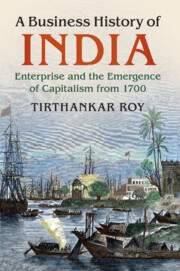Book contents
- A Business History of India
- A Business History of India
- Copyright page
- Dedication
- Contents
- Figures
- Maps
- Tables
- Boxes
- Preface
- 1 Introduction
- 2 The Baseline at 1700
- 3 The Indian Ocean Sphere: 1700–1850
- 4 Capital and Empire (1850–1930)
- 5 Capital and Empire (1850–1930)
- 6 State and Industrialisation: 1930–1950
- 7 State and Industrialisation: 1950–1980
- 8 Revival: 1980–2000
- 9 Capital and Globalisation: 2000–2015
- 10 Conclusion
- References
- Index
8 - Revival: 1980–2000
Published online by Cambridge University Press: 20 March 2018
- A Business History of India
- A Business History of India
- Copyright page
- Dedication
- Contents
- Figures
- Maps
- Tables
- Boxes
- Preface
- 1 Introduction
- 2 The Baseline at 1700
- 3 The Indian Ocean Sphere: 1700–1850
- 4 Capital and Empire (1850–1930)
- 5 Capital and Empire (1850–1930)
- 6 State and Industrialisation: 1930–1950
- 7 State and Industrialisation: 1950–1980
- 8 Revival: 1980–2000
- 9 Capital and Globalisation: 2000–2015
- 10 Conclusion
- References
- Index
Summary
The government introduced certain freedoms in the 1980s. There was not yet a publicly announced reform; the only thing that may explain this was that labour export from India had improved the balance of payments (see Fig. 7.4), the economy was regaining the capacity to import machines again, and this is exactly what was allowed, if on a selective basis. The easing off began with a decision to let the currency float, and depreciate. The government was forced to devalue after the oil crisis; once it was done, it was easy to repeat. During Rajiv Gandhi's Prime Ministership (1985–91), the Textile Policy, which had prevented cotton mills from modernising, was reformed (1985), and investment limits on the so-called ‘monopoly houses’ were relaxed. Price control on some goods including cement was removed, more goods were shifted from import licence list to tariff list, and FERA enforcement relaxed again. Portfolio investment by non-resident Indians was permitted around 1980, and almost immediately, led to a messy takeover case involving UK's Caparo, and India's DCM and Escorts.
These were disjointed steps, and did not add up to much. Politics was torn between reform, or less state intervention than before, and equity, or more state intervention than before. Too many regulatory roadblocks remained for this to be called a liberalisation. Tariff rates were still high. Bankruptcy, labour militancy, and corporate governance crises took extreme forms in traditional businesses. Industrywide strikes in engineering, cotton textiles, and jute caused disruption to the economies of whole regions (Chapter 7). Several business families split up, and some became obscure after doing so.
Still, there were signs of revival in private investment (see also Fig. 8.1). Behind the revival, there were six processes at work. First, the silent softening of the exchange rate encouraged export of garments and leather goods. Although the main beneficiary of the change were small firms, many larger companies set up subsidiaries to take advantage of the export boom. Second, the slight relaxation of import policy encouraged modernisation and investment in new areas. Third, applications to start joint ventures between Indian and foreign partners were reviewed liberally, so that more foreign investment and foreign technology came in even when import licence and foreign investment policy restrictions remained in place. Fourth, the Green Revolution stimulated consumption and encouraged fresh investment in farm equipment and chemical fertilisers.
- Type
- Chapter
- Information
- A Business History of IndiaEnterprise and the Emergence of Capitalism from 1700, pp. 203 - 239Publisher: Cambridge University PressPrint publication year: 2018



